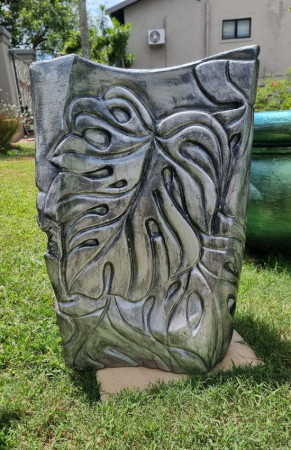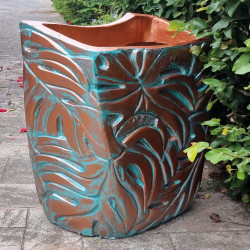Tarnish Effect Paint
Availability:
- Creates a black tarnished effect on silver or gold (select the metallic colour that you require).
- You will always receive Metallic Paint, Tarnish Paint and Clear Top Coat.
- Simple and Durable. Suitable for Interior & Exterior.
TARNISH EFFECT ON GOLD AND SILVER
Explanation of Tarnish on Silver and Gold
Silver
Gold
24 carat gold is pure gold and does not tarnish i.e. it keeps its original shiny colour. 24ct gold is too soft for jewellery so gold is usually mixed with other metals to make for example 22ct, 18ct or 9ct gold. This means that the gold is a metal alloy with various other metals mixed into the gold to harden it. In the USA the spelling is Karat (symbol K). 18ct Gold has 18 parts of gold and 6 parts of other metals (24 parts in total). Another way to express this is that 18ct gold has 75% gold and 25% other metals.
Gold is alloyed (mixed) with other metals such as silver, copper, zinc, nickel, tin, manganese, cadmium or titanium to make gold jewellery. The alloy metals increase the hardness of the gold and can help the gold gain a higher polish and brighter lustre. It is these other metals alloyed with gold that react with household chemicals or react naturally in air (with oxygen, sulfur containing chemicals and moisture). Such reactions discolour or tarnish the gold and make your gold look grey or black. The tarnish only forms a thin surface layer and does not weaken the gold.
What we supply
- Metallic Paint (Silver or Gold)
- Tarnish Paint
- Clear Top Coat
Instructions: Creating a Tarnish Effect using the supplied Bastion Paint products
Step 1: Paint the surface with Metallic Paint
Apply one coat of the Tarnish Paint over the metallic colour using a normal paint brush.
There are numerous ways to create an aged tarnish effect. All involve removing some of the Tarnish Paint to expose the underlying metallic colour. The more Tarnish Paint that you leave on, the older and more oxidised the appearance will be but always have at least 50% of the surface showing the underlying metallic colour.
Use one or a combination of the following methods to easily remove some Tarnish Paint:
- Wipe the Tarnish Paint with a dry cloth before it has fully dried.
- Wipe the dry Tarnish Paint with a damp cloth. On larger objects you may need to rinse the cloth several times.
- Use a dry steel brush or sandpaper to remove dry Tarnish Paint. This takes more effort that the above two methods.
If you intend to scrub or sand off the dry Tarnish Paint, then let the underlying metallic colour (copper, bronze or brass) dry for 2 days before painting over it with Tarnish Paint. This is to ensure the metallic colour is hard enough to not be damaged by the mechanical process.
Scrubbing and sanding will create dust so do this outside while wearing a fabric dust mask.
Step 3: Apply Clear Top Coat to seal
Dust off the surface well with a dry cloth (no water) and then apply 2 coats of our Clear Top Coat over the Metallic and Tarnish Paints to seal them. Pour the Clear Top Coat that you intend to use into a separate container so that you don't contaminate the Clear Top Coat that you do not use.
When applying the first coat, the Tarnish Paint will tend to come off onto your paint brush and then get into the Clear Top Coat which can result in a dulling of the metallic colour or even a smudged appearance. Use a new soft paint brush and apply the first coat of Clear Top Coat lightly without trying to get a perfect finish or cover every single spot. Before dipping the brush into the Clear Top Coat again, squeeze the brush out by pressing it on the side of a waste container. For larger items with a high amount of Tarnish Paint left on, you will need to wash your paint brush as you go. One simple way is to wash your paint brush with water when it becomes blackish, dry it with a hair dryer and then continue.
Once the first coat of Clear Top Coat has dried, apply a second coat. Paint normally and cover all areas.
After this has dried, the painted item will be fine for exterior conditions. It will not fade and will be fully washable.
Unit Size |
|
| Unit Size |
110ml
350ml
1 Litre
5 Litre
|
Metallic Colour |
|
| Metallic Colour |
Bright Silver
Deep Silver
Brass
Antique Gold
|
| Metallic Colour & Finish | |









